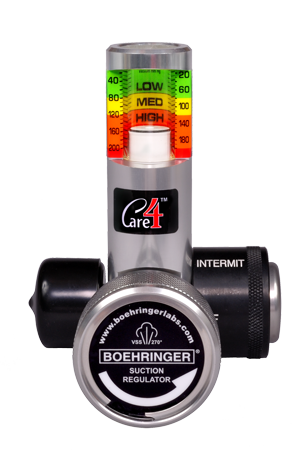The COVID-19 pandemic has affected the delivery of healthcare and operations-related facilities in the United States. In response, many hospitals have implemented enhanced environmental cleaning and disinfection protocols, especially on equipment used for respiratory therapy. The effects of the virus SARS-CoV-2 can cause inflamed airways, making it hard to breathe. A ventilator, which mechanically helps pump oxygen to your body, must be used and contained within the system is a suction regulator. Even before the pandemic, suction regulators have long been recognized as a potential source of pathogenic cross-contamination to patients, nursing staff, and biomedical technicians. Only Boehringer suction regulators can be autoclaved to ensure precision sterility and safety to patients and staff.
Over 30 years ago, Earle H. Spaulding devised an approach to disinfect and sterilize patient-care items and equipment, categorizing them as critical, semicritical, and noncritical. Semicritical items, including respiratory therapy equipment, “should be free from all microorganisms; however, small numbers of bacterial spores are permissible. Intact mucous membranes, such as those of the lungs and the gastrointestinal tract, generally are resistant to infection by common bacterial spores but susceptible to other organisms, such as bacteria, mycobacteria, and viruses.”[1] In 2001, ECRI analyzed all suction regulators, stating that “aspirate can contaminate a regulator and expose personnel, and possibly patients to a wide variety of infectious microorganisms…after every procedure, regulators should be decontaminated and sterilized properly in accordance with manufacturer recommendations.”[2] In 2010, an article by Keith Kaye, MD, found that a contaminated suction regulator on intermittent setting can cross-contaminate the suction canister and suction circuit in as little as 30 minutes. The contaminated circuit can cross-contaminate from suction regulator to patient in a little as 8 hours.
COVID-19 is a virus. An ineffectively cleaned infected regulator can quickly cross-contaminate to a clean canister, which can cross-contaminate to patient anatomy, which is inherently susceptible to viral incursion.
Boehringer suction regulators are the only suction regulator in the world that can be autoclaved. An autoclave is a machine that uses steam under pressure to kill harmful bacteria, viruses, fungi, and spores on items that are placed inside a pressure vessel. Autoclaving is one of the most effective methods for destroying all types of microorganisms, including spores. All other regulators will not withstand the process of autoclaving.
Looking for more information on solutions for clinical suction? Be sure to check out Boehringer Suction Regulators.
[1] “A Rational Approach to Disinfection and Sterilization: Guideline for Disinfection and Sterilization in Healthcare Facilities (2008).” Center for Disease and Infection Control. Page last reviewed: September 18, 2016, https://www.cdc.gov/infectioncontrol/guidelines/disinfection/rational-approach.html
[2] “Regulators, Suction.” Healthcare Product Comparison System. ECRI. January 2001.
Back to Blog


